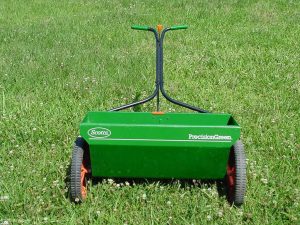
Drop Spreader
Option 1. Calibrating a Drop Spreader by the Multiple Pass Method (see below)·
Option 2. Calibrating a Drop Spreader by the Single Pass Method (see below).
Option 3. Calibrating a Drop Spreader by Swath Width and Distribution Pattern (link)
Multiple Pass Method
Calibration Steps |
Sample Problem |
| 1. Measure the length and width and calculate the total square footage of the area to be treated. | 120 ft x 70 ft = 8400 ft2 |
| 2. Calculate the total area occupied by the house, sidewalks, driveway, plantings, etc., and subtract from the total area determined in the first step. | |
| 3. Read the label to determine how many square feet one bag of product will cover. | 5000 ft2 |
| 4. Divide the number in Step 2 by the number in Step 3 to determine how many bags would be needed to treat the entire area. | 6300 + 5000 = 1.26 bags (about 1 1/4 bags) |
| 5. Set the gate lower than the 5 3/4 recommended setting given by the product label or the owner’s manual for the spreader. | Set the gate at 2 ½ |
| 6. Place about a half of bag of product into the hopper. | |
| 7. Push the drop spreader back and forth across the lawn until the product is gone. Fill the hopper with another half bag and repeat the treatment at right angles to the first application. Continue until 1 ¼ bags are completely used. | Make sure that the wheel tracks of each pass slightly overlap the tracks from the previous pass. |
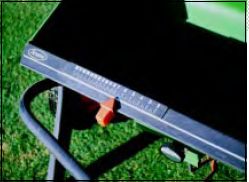
Gate Adjustment
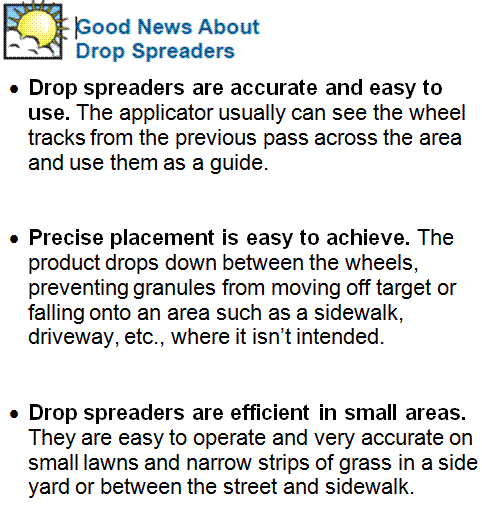
Single Pass Method
Calibration Steps |
Sample Problem |
| 1. Set the gate openings on your spreader using the product label directions; or set them so that they are slightly larger than the granules. Read the label recommended rate of application. | Gate setting – 5 ¾ Label rate – 20 lb/ 5,000 ft2 or 4 lb / 1,000 ft2 |
| 2. Measure the width of the bottom of the hopper between the wheels. | Length – 24 in |
| 3. Convert the inches in Step 2 to feet by dividing by 12 | Length – 2 ft |
| 4. Measure and mark a convenient distance on clean pavement such as a driveway; fifty feet is suggested. Ten passes back and forth along this distance will result in the release of enough product, to calibrate the equipment accurately. | 50 ft x 10 passes = 500 ft |
| 5. Compute the area covered by multiplying the length of the hopper
(Step 3) times the length of the area (Step 4). |
2 ft x 500ft2= 1,000 ft2 |
| 6. Weigh the amount of product that you use to fill the hopper. Turn the spreader on and push it over the test strip ten times, using a consistent walking speed. Be sure to turn the spreader off, immediately, when you reach the end of the test strip | Put 5 lb of product in the hopper |
| 7. Weigh the amount of product that is left in the hopper. | 1 lb left in hopper |
| 8. Compute the amount of product that was used to cover the test area by subtracting the leftover amount (Step 7) from the amount put into the hopper (Step 6). The result represents the amount of product applied to the 1,000 -square-foot test area. | 5 lb – 1lb = 4 lb / 1,000 ft2 |
| 9. If the amount of the product used (Step 8) is within 10 percent (high or low) of the label-recommended rate (Step 1), the spreader is calibrated correctly. If the amount of product is not between 90 and 110 percent of the labeled rate, (that is, if it is not within ±10 percent), reset the gate openings and repeat the process. | In this case, 4 lb per 1,000 ft2 equals the label rate of 20 lb per 5,000 ft2. So no additional adjustments are necessary. |
| 10. Determine the area to be treated by multiplying its length times its width and subtracting the square footage of areas that will not be to be treated. | From option 1, the total area to be treated id 6,300ft2 |
| 11. Apply the product according to label directions, using the gate setting determined in calibrating the spreader. | 6,300ft2 ÷ 5,000 ft2 per bag = 1.26 bags |
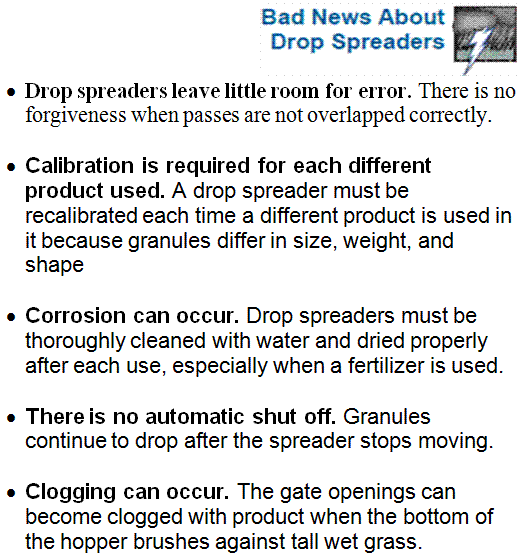
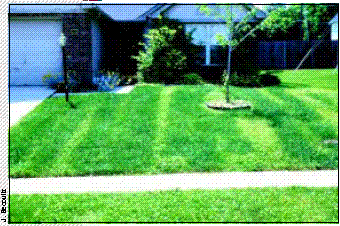
Compiled by Wayne Buhler, PhD.
